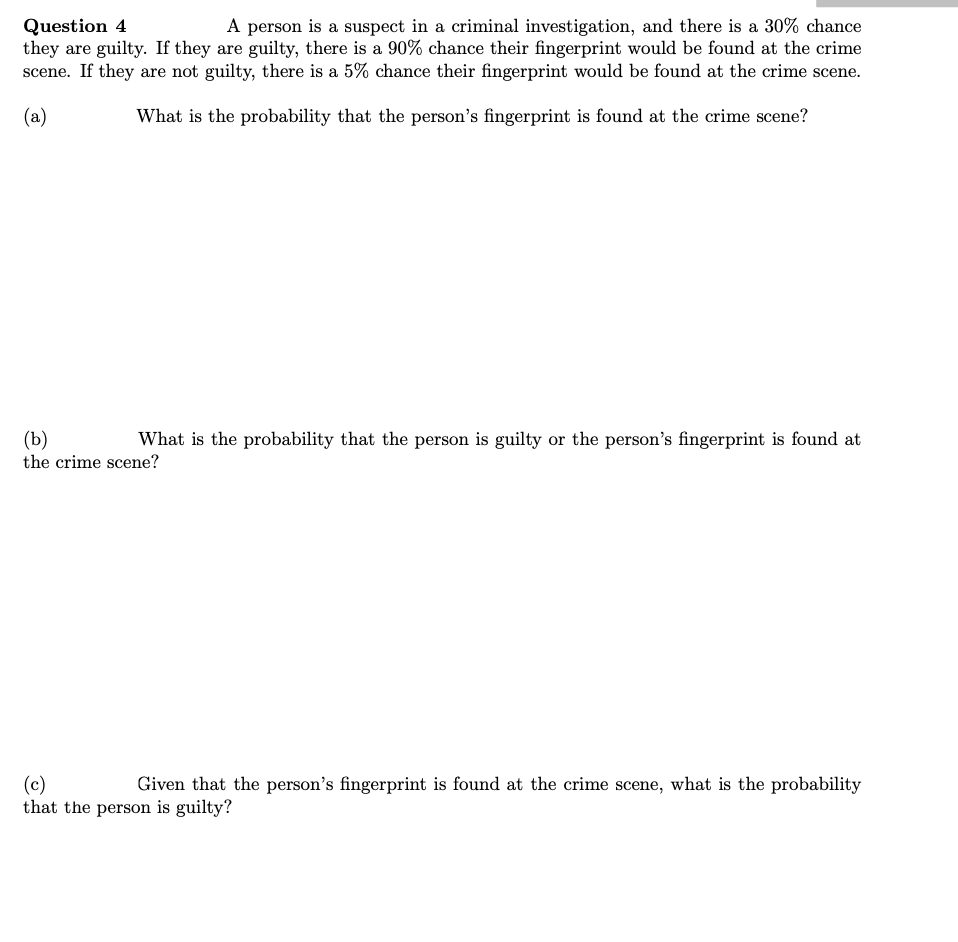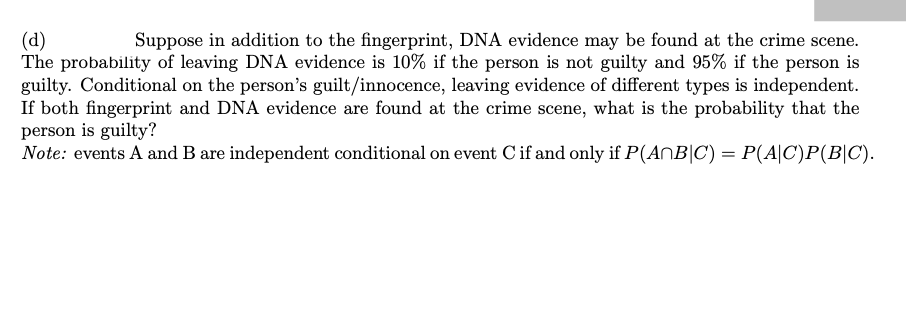(d) The probability of leaving DNA evidence is 10% if the person is not guilty and 95% if the person is guilty. Conditional on the person's guilt/innocence, leaving evidence of different types is independent. If both fingerprint and DNA evidence are found at the crime scene, what is the probability that the person is guilty? Note: events A and B are independent conditional on event C if and only if P(ANB|C) = P(A|C)P(B|C). Suppose in addition to the fingerprint, DNA evidence may be found at the crime scene.
(d) The probability of leaving DNA evidence is 10% if the person is not guilty and 95% if the person is guilty. Conditional on the person's guilt/innocence, leaving evidence of different types is independent. If both fingerprint and DNA evidence are found at the crime scene, what is the probability that the person is guilty? Note: events A and B are independent conditional on event C if and only if P(ANB|C) = P(A|C)P(B|C). Suppose in addition to the fingerprint, DNA evidence may be found at the crime scene.
Holt Mcdougal Larson Pre-algebra: Student Edition 2012
1st Edition
ISBN:9780547587776
Author:HOLT MCDOUGAL
Publisher:HOLT MCDOUGAL
Chapter11: Data Analysis And Probability
Section11.8: Probabilities Of Disjoint And Overlapping Events
Problem 2C
Related questions
Question
Solve c,d

Transcribed Image Text:Question 4
they are guilty. If they are guilty, there is a 90% chance their fingerprint would be found at the crime
scene. If they are not guilty, there is a 5% chance their fingerprint would be found at the crime scene.
A person is a suspect in a criminal investigation, and there is a 30% chance
(a)
What is the probability that the person's fingerprint is found at the crime scene?
What is the probability that the person is guilty or the person's fingerprint is found at
(Ъ)
the crime scene?
(c)
that the person is guilty?
Given that the person's fingerprint is found at the crime scene, what is the probability

Transcribed Image Text:(d)
The probability of leaving DNA evidence is 10% if the person is not guilty and 95% if the person is
guilty. Conditional on the person's guilt/innocence, leaving evidence of different types is independent.
If both fingerprint and DNA evidence are found at the crime scene, what is the probability that the
person is guilty?
Note: events A and B are independent conditional on event C if and only if P(ANB|C) = P(A|C)P(B|C).
Suppose in addition to the fingerprint, DNA evidence may be found at the crime scene.
Expert Solution
This question has been solved!
Explore an expertly crafted, step-by-step solution for a thorough understanding of key concepts.
Step by step
Solved in 2 steps

Recommended textbooks for you

Holt Mcdougal Larson Pre-algebra: Student Edition…
Algebra
ISBN:
9780547587776
Author:
HOLT MCDOUGAL
Publisher:
HOLT MCDOUGAL


Algebra & Trigonometry with Analytic Geometry
Algebra
ISBN:
9781133382119
Author:
Swokowski
Publisher:
Cengage

Holt Mcdougal Larson Pre-algebra: Student Edition…
Algebra
ISBN:
9780547587776
Author:
HOLT MCDOUGAL
Publisher:
HOLT MCDOUGAL


Algebra & Trigonometry with Analytic Geometry
Algebra
ISBN:
9781133382119
Author:
Swokowski
Publisher:
Cengage